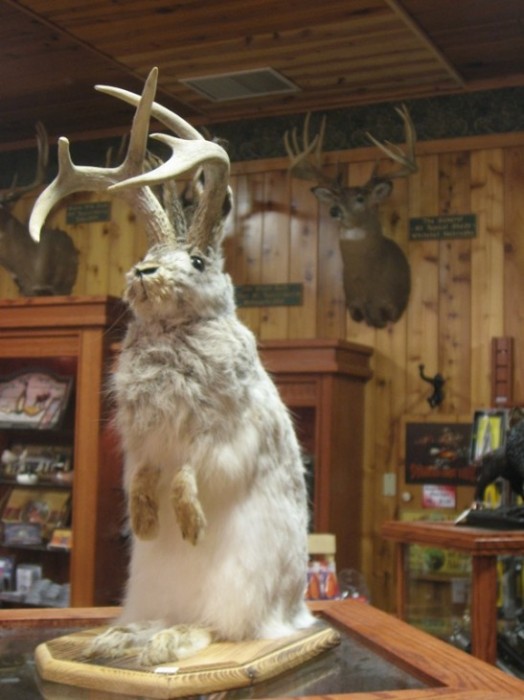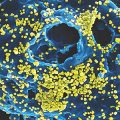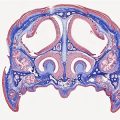The Legend of the Jackalope

(Postcard) The Fabulous Jackalope.
“Jackalopes, one of the rarest animals in North America, are a cross between an Antelope and a species of rabbit. They are extremely shy and wild, and possess the ability to mimic. Their cries often sound human and tuneful.”
Scenic Art, Berkeley, Calif.
Among the bats, rats and other ferocious animals that lie within the storage drawers of the mammal collection in the Smithsonian’s National Museum of Natural History in Washington, D.C., an unusual freak of nature can be found.
The jackalope, also commonly known as a ‘Frankenstein’ rabbit, is the stuff of nightmares, with elongated horns protruding from its furry little head. The mythological jackrabbit with the horns of an antelope is an American legend, one that young biology students are taught to regard with the same disbelief as unicorns and werewolves.
So when one of the museum’s mammal collection managers, Suzanne Peurach, from U.S. Geological Survey Patuxent Wildlife Research Center, discovered an eastern cottontail rabbit with horny facial growths in the collection, she could not believe it was real.
“When I pulled the rabbit out of the box I thought this must be a joke. I went to school in Albuquerque, N. M., and everywhere you go there are jackalopes in biology professors’ offices and even being sold in stores,” Peurach explains.
“Those are fake animals, the result of people sewing taxidermy rabbits and deer antlers together. This rabbit was definitely not one of those.”
Indeed the rabbit was real, and after conferring with Robert Hoffmann, senior Smithsonian mammologist and world authority on rabbits and hares, Peurach learned that the rabbit was infected by Shope papilloma virus. The virus infects rabbits and hares worldwide, causing tumors to grow in various places on a rabbit’s head and body.
The Shope papilloma virus is a cancer-causing strain related to the human papillomavirus, or HPV. Whereas HPV corrupts cells in the human cervix to build cancerous tumors, in rabbits the papillomavirus manifests as hard, keratinized horns. If they develop near the mouth, the tumors can become large enough that they interfere with the host’s ability to eat, eventually causing starvation. Such papillomaviruses are found throughout the animal kingdom, including in other mammals, birds and reptiles.

Mammal collection manager, Suzanne Peurach, with the specimen collected north of Lawrence , Kansas in 1955. (Photo Micaela Jemison)
Although American virologist Richard Shope discovered the virus in the 1930s, its distinctive symptoms in rabbits and hares have mystified and inspired people for centuries. Descriptions of horned hares as real or mythical creatures date back to medieval and early Renaissance times, appearing in Bavarian folklore and early scientific texts. Stories and illustrations of horned rabbits as real animals last appeared in scientific books in the late 1700s, after which the idea of a horned hare as a distinct species was mostly rejected.
Sightings of virus-affected rabbits in North America are thought to have influenced the resurrection of the horned rabbit legend. The term “jackalope” was most likely coined by taxidermists who reproduced the horned hare of legend by grafting pronghorn horns onto the mounted head or complete body of a jackrabbit.

Plate XLVII of Animalia Qvadrvpedia et Reptilia (Terra) by Joris Hoefnagel, circa 1575, showing a “horned hare” (Photo via Wikipedia)
Posted: 31 October 2014
-
Categories:
Feature Stories , History and Culture , Natural History Museum , Science and Nature









